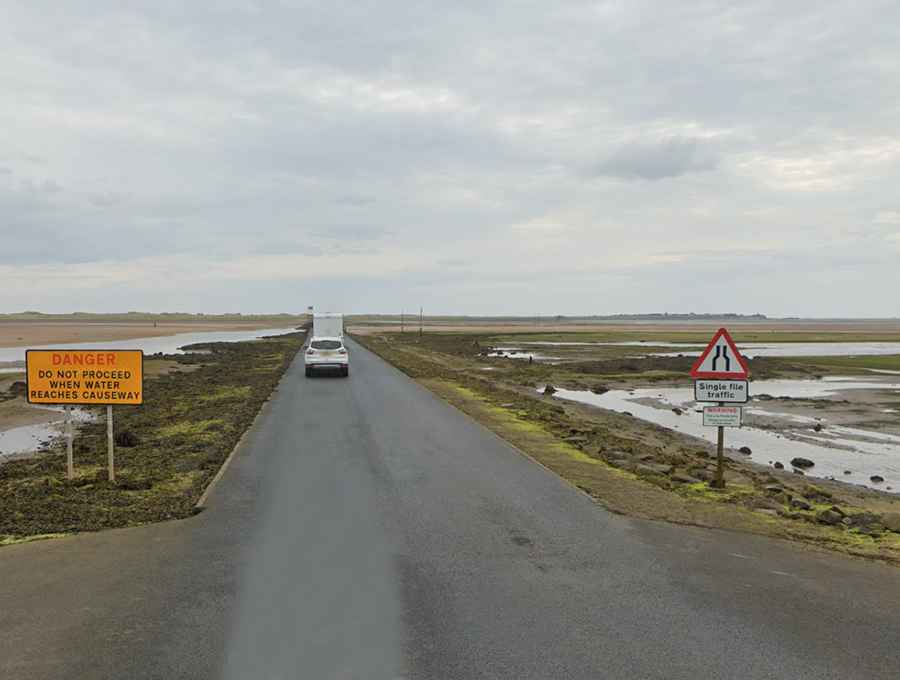Lindisfarne Causeway is the road that floods twice each day
Located in the county of Northumberland, it lies on a tidal island known as Holy Island, also called Lindisfarne. Twice a day, the ancient path to the island disappears with the tides, leaving the Holy Island of Lindisfarne out to sea. Each year, there are many reports of people 'risking it' and having to be rescued from one of the raised safety points on the causeway. It’s one of the periodically flooded roads around the world.

Where is Lindisfarne?
Tucked away in the extreme northeast corner of England, just a few miles south of the border with Scotland, Lindisfarne, also known as the Holy Island of Lindisfarne, is a historic small tidal island located in the west North Sea, 2 mi (3 km) from English Northumberland. Holy Island’s importance as a religious center dates from AD 635 when the ecclesiastic St. Aidan established a church and monastery there with the aim of converting the Northumbrians. From here, the Christian message flourished throughout the world.
What is Lindisfarne Causeway?
The island is accessible by a paved metalled causeway, called Lindisfarne Causeway, which is covered by the North Sea twice in every 24-hour period. This stunning and remote island is home to Lindisfarne Castle and Priory and is surrounded by breathtaking coastal scenery. It gets 650,000 visitors from all over the world every year.
When was Lindisfarne Causeway built?
It’s said to be England's greatest secret. The modern causeway that is cut off twice a day by the tides is about a mile long. The causeway was constructed in the mid-1950s. Until then—for 1,300 years—the Pilgrims Way footpath, marked with a line of upright poles, was the only access to the island. To avoid skidding on this slippery road, drive more slowly to avoid having to brake suddenly when needed. In general, operate the vehicle controls slowly. In case of dense fog, turn on your headlights and your fog lights front and rear (if available). The route is exposed, so this ride may suit older children and is best done in dry and settled weather. It is also strictly forbidden to park on the pavement. When this paved sandbar that’s flooded twice a day at high tide isn’t submerged, this narrow causeway is a slippery stretch indeed and especially treacherous on two wheels. In summers, expect high traffic along the way. Anyone who thinks they or someone else is in danger should call 999 immediately and ask for the coastguard.
Can you drive through Lindisfarne Causeway?
Located within the Lindisfarne National Nature Reserve, at the mouth of the River Tweed on the east coast, the Island has some fascinating history. The journey will stay in your memory forever. The tides can rise suddenly, so pay attention to the posted tidal notices. There are elevated safety refuge boxes along the path in case of mistiming, and there are also local guides to help visitors get it right. Anyway, each year there are many reports of people 'risking it' and having to be rescued from one of the raised safety points on the causeway. Their cars aren't as lucky, though, and are generally ruined, so the lesson here is don't take risks! It's not just the actual causeway that is covered by the sea. Parts of the road leading along the shore from a point only a little north of the main village car park are also submerged by the tide. When the tide is in, this effectively becomes a place that is best explored on foot. The causeway is becoming a regular scene for dramatic rescue operations by boat crews from the Royal National Lifeboat Institution because car drivers are not reading the tide tables. None of those who are caught out are locals; it's always people who are visiting the area. Remember the road floods twice daily with incoming tides and as the tides go out slippery seaweed is left all over it. The causeway is closed two hours before high tide and until three hours after. Make sure you check the tide tables. At high tide, the road lies under 1.5 - 4 meters of water.
Is the Lindisfarne Causeway open?
Today the causeway attracts thousands of visitors a year to watch the twice-daily uncovering of the causeway as it miraculously appears from the sea during the ebbing tide. Be sure to check for safe crossing times on the causeway's notice board before journeying to Holy Island. Vehicles can only cross the causeway when the tide is open. Opening times vary significantly every day, and you should familiarize yourself with the causeway opening times for the day of your visit. Unless you 'stop-over' (from when the causeway closes until it opens again), you could find yourself having to leave within 7 hours of getting here. Consequently, you may be forced to limit your 'day on Lindisfarne' to activities 'around the village'.